|
Dallas
Fax-On-Demand: (214) 767-9613 Bureau of Labor Statistics Dallas/Kansas City Regional Office Cheryl Abbot, Economist (214) 767-6970 http://www.bls.gov/ro6/ |
Document
No. 9580 |
Average Annual Wages in the Southwest States, 2002
The average annual wages of employees in the Southwest states ranged from $28,074 in Arkansas to $36,248 in Texas in 2002, according to data from the U.S. Department of Labor’s Bureau of Labor Statistics (BLS). Acting Regional Commissioner John Gordon noted that wages in all four states in the region trailed the national average of $36,764. (See table 1.)
Texas ranked 16th highest in wages nationally and was the lone state in the Southwest to place among the top half of all states. Louisiana’s wage level ($30,115) ranked 37th, Oklahoma’s ($28,654) placed 44th and Arkansas’ 47th. Arkansas’ wage level was fifth lowest in the nation; only workers in Montana ($26,001), South Dakota ($26,360), North Dakota ($26,550), and Mississippi ($26,665) earned less. In addition, these five states have had the lowest average annual wages since 1988. Wages in the District of Columbia ranked first at $57,914, followed by Connecticut ($46,852) and New York ($46,328). (See table 2.)
In Arkansas, Louisiana, and Oklahoma, the rate of wage growth exceeded the national gain of 1.5 percent. Louisiana’s wage growth of 3.4 percent ranked 6th highest nationally, slipping from 5th place in 2001. Arkansas’ wage increase of 3.0 percent ranked 13th in the nation and Oklahoma’s 2.3-percent gain was 30th. Texas was the sole state in the Southwest to exhibit wage growth below the national average, as it increased by 0.6 percent and ranked 46th nationally.
Overall, wage gains throughout the nation declined sharply in 2002 compared with the previous year. Only thirteen states experienced higher annual wage growth in 2002 than in 2001, none of which were in the Southwest. Three states, Connecticut, Massachusetts, and New York reported lower levels of annual wages compared to 2001.
Wage differences among states reflect the varying composition of employment by occupation, industry, and hours of work, as well as other factors. Similarly, over-the-year wage changes may reflect shifts in these characteristics, as well as changes in the level of average wages. Annual wage data are compiled from reports submitted by employers subject to state and federal Unemployment Insurance (UI) laws that covered workers in 128.2 million full- and part-time jobs nationwide. Average annual wages are computed by dividing total annual wages of employees covered by UI programs by the average monthly number of these employees. (See Technical Note.)
Industry wages
Among the Southwest states, private industry wages grew fastest in Arkansas (2.9 percent) in 2002. Arkansas’ wage growth was followed closely by Louisiana at 2.8 percent and Oklahoma at 2.0 percent. All three states registered growth faster than that of the nation (1.1 percent). Private industry wages slipped by 0.1 percent in Texas; the State was one of only a handful nationwide (California, Colorado, Connecticut, Massachusetts, and New York) to register a decline.
Mining, which includes crude petroleum and natural gas exploration, led all other private sector industries in average annual wages for Texas and Louisiana, the two highest paying states in the Southwest. Mining wages in Texas, at $79,894, led the region and were well above the national industry average of $60,392. (See table 3.) In Arkansas management of companies and enterprises was the highest paid industry in the private sector at $60,180; in Oklahoma, utilities paid the most ($53,802). Nationally, management of companies and enterprises was the wage leader averaging $69,277. The accommodation and food services industry, reflecting its relatively large share of part-time workers, had the lowest annual wages nationally ($13,946) and regionally, with all four states falling below the U.S. average. Wages for accommodation and food service workers in Arkansas, at $10,208, were among the lowest in the nation, trailed only by Wisconsin ($10,010), Iowa ($9,993), South Dakota ($9,948), and North Dakota ($9,352).
Metropolitan area wages
Among the 44 metropolitan areas in the Southwest, Dallas, Texas led the region with an average annual wage level of $43,000, followed closely by Houston, Texas at $42,712 and Austin-San Marcos, Texas with $39,540. These three areas were the only ones in the region to exceed the national metropolitan average of $38,423, among 37 areas nationwide to do so. Of the 318 metropolitan areas in the United States, Dallas ranked 19th highest in wages, while Houston ranked 20th and Austin-San Marcos, 29th. Brownsville-Harlingen-San Benito, Texas, and McAllen-Edinburg-Mission, Texas, both along the Texas-Mexico border, had the lowest wage levels in the region at $22,892 and $23,179, respectively. The two areas had among the lowest average annual wage levels nationwide as well. (See table 4.)
Most areas in the Southwest experienced wage growth greater than the 1.4-percent increase for all metropolitan areas nationwide. Nationally, the same trend occurred, as approximately 80 percent of all metropolitan areas had increases above the U.S. average. In the southwestern states, Texarkana, Texas-Texarkana, Ark. registered the largest over-the-year increase in wages at 4.6 percent, followed by New Orleans, Louisiana, and Killeen-Temple, Texas, both at 4.2 percent. Over-the-year declines were recorded for Houston, Texas (-0.2 percent), Sherman-Denison, Texas (-1.0 percent), and Austin-San Marcos, Texas (-3.2 percent). Austin-San Marcos was the only area in the Southwest to register a decline (-0.4 percent)in 2001 as well.
TECHNICAL NOTE
Background
These data are the product of a federal-state cooperative program known as Quarterly Census of Employment and Wages (QCEW) in which State Employment Security Agencies (SESAs) prepare summaries of employment and total wages of workers covered by Unemployment Insurance legislation. The summaries are a by-product of the administration of state unemployment insurance (UI) programs that require most employers to pay quarterly taxes based on the employment and wages of workers covered by UI.
Coverage
Employment and wage data for workers covered by state UI laws and for federal civilian workers covered by the Unemployment Compensation for Federal Employees (UCFE) program are compiled from quarterly contribution reports submitted to the SESAs by employers. In addition to the quarterly contribution reports, employers who operate multiple establishments within a state complete a questionnaire, called the "Multiple Worksite Report," which provides detailed information on the location and industry of each of their establishments. Average annual wage data are derived from summaries of employment and wages submitted by states to the Bureau of Labor Statistics. These reports are based on place of employment rather than place of residence.
UI and UCFE coverage is broad and basically comparable from state to state. In 2002, UI and UCFE programs covered workers in 128.2 million jobs. Covered workers received $4.713 trillion in wages, representing 94.3 percent of the wage and salary component of personal income and 45.1 percent of the gross domestic product.
Major exclusions from UI coverage include self-employed workers, most agricultural workers on small farms, all members of the Armed Forces, elected officials in most states, most employees of railroads, some domestic workers, most student workers at schools, and employees of certain small nonprofit organizations.
Concepts and methodology
Average annual wages was computed by dividing total annual wages of employees covered by UI programs by the average monthly number of these employees. In addition to salaries, average annual wages data include bonuses, the cash value of meals and lodging when supplied, tips and other gratuities, and, in some states, employer contributions to certain deferred compensation plans such as 401(k) plans, and stock options. Monthly employment is based on the number of workers who worked during or received wages for the pay period including the 12th of the month. With few exceptions, all employees of covered firms are reported, including production and sales workers, corporation officials, executives, supervisory personnel, and clerical workers. Workers on paid vacations and part-time workers also are included.
Average annual wages are affected by the ratio of full-time to part-time workers as well as the number of individuals in high-paying and low-paying occupations. When comparing average annual wage levels between industries and/or states, these factors should be taken into consideration. Annual wage data only approximate annual earnings because an individual may not be employed by the same employer all year or may work for more than one employer. Also, year-to-year changes in average annual wages can result from a change in the proportion of employment in high- and low-wage jobs, as well as from changes in the level of average annual wages.
In order to insure the highest possible quality of data, SESAs verify with employers and update, if necessary, the industry, location, and ownership classification of all establishments on a 3-year cycle. Changes in establishment classification codes resulting from the verification process are introduced with the data reported for the first quarter of the year. Changes resulting from improved employer reporting also are introduced in the first quarter. For these reasons, some data, especially at more detailed industry levels, may not be strictly comparable with earlier years.
A few covered employers provided insufficient information on the nature of their businesses to enable the SESA to assign a specific NAICS code. The establishments of these employers therefore could not be classified by industry sector. The wages for these nonclassifiable establishments, along with data for the agricultural division, are not shown separately, but are included in the averages for state and national totals.
The Office of Management and Budget (OMB) defines metropolitan areas for use in federal statistical activities and updates these definitions as needed each summer—data in this release use criteria established in definitions issued June 30, 1999 (OMB Bulletin No. 99-04). The 318 metropolitan areas in the United States are a compilation of a set of areas classified as Metropolitan Statistical Areas (MSAs), Primary Metropolitan Statistical Areas (PMSAs) and Consolidated Metropolitan Statistical Areas (CMSAs). Generally speaking, an MSA consists of one or more counties and meets specified size criteria—either it contains a city of at least 50,000 inhabitants, or it contains an urbanized area of at least 50,000 inhabitants, and has a total population of at least 100,000 (75,000 in New England). A CMSA is a metropolitan area that has a population of at least 1 million and has been divided into two or more PMSAs. The CMSA comprises the same geographic area as its constituent PMSAs which are loosely defined as free-standing areas that have a population of at least 100,000.
Additional statistics and other information
Additional average annual wages data (or Quarterly Census of Employment and Wages data) are available on the BLS Internet site at http://www.bls.gov/cew/. Beginning in October 2002, quarterly data are available for selected QCEW series. Data can be accessed in several ways including Selective Access, which allows quick access to particular items, and the special request FTP service, which allows access to an extensive collection of flat text files. The Dallas Information Office can provide assistance accessing these files by calling 214-767-6970.
This news release, along with other BLS statistics and information, is available via the Internet at http://www.bls.gov/ro6/home. Copies of this release can also be obtained from the Bureau’s fax-on-demand service in Dallas by dialing 214-767-9613 and requesting document 9580.
An annual bulletin, Employment and Wages, features comprehensive information by detailed industry on establishments, employment, and wages for the nation and all states. Employment and Wages, Annual Averages, 2002 is available for sale from the BLS Publications Sales Center, P.O. Box 2145, Chicago, Illinois 60690, telephone 312-353-1880. This bulletin is now available in portable document format (PDF) on the BLS Web site at http://www.bls.gov/cew/cewbultn02.htm
News releases on quarterly measures of gross job flows also are available upon request from the Division of Administrative Statistics and Labor Turnover (Business Employment Dynamics), telephone 202-691-6467; http://www.bls.gov/bdm/; or send email.
Information in this release will be made available to sensory impaired individuals upon request. Voice phone: 202-691-5200; TDD message referral phone number: 1-800-877-8339. For personal assistance or further information on annual average wage data as well as other Bureau programs, contact the Dallas Information Office in Dallas at 214-767-6970 from 8:00 a.m. to 11:00 a.m. and 1:00 p.m. to 4:00 p.m. central time.
1The Southwest referenced in this release is comprised of Arkansas, Louisiana, Oklahoma and Texas and corresponds to the West South Central Census division.
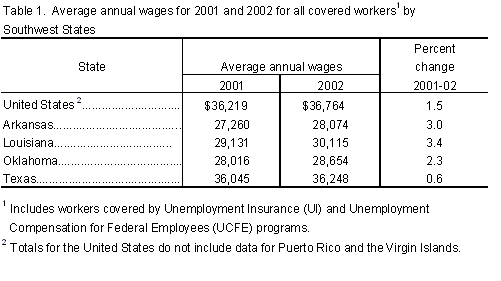
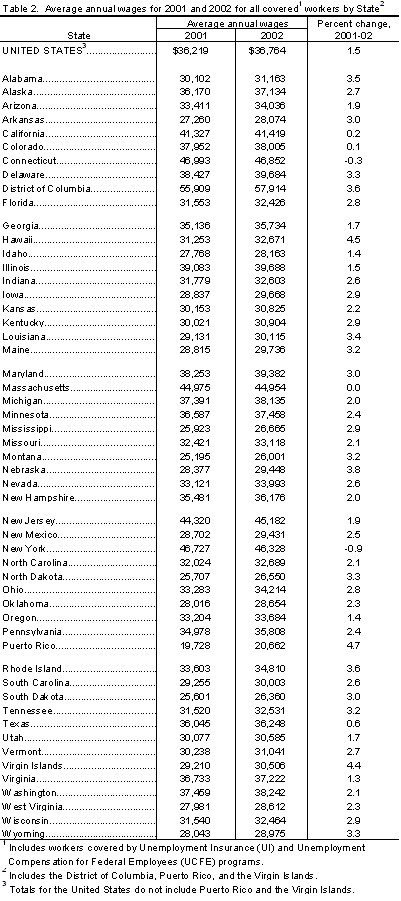
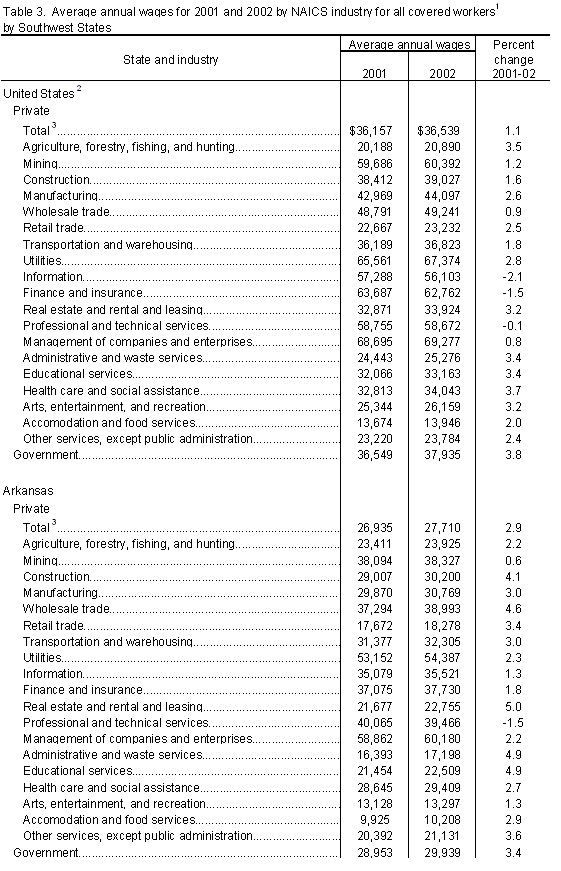
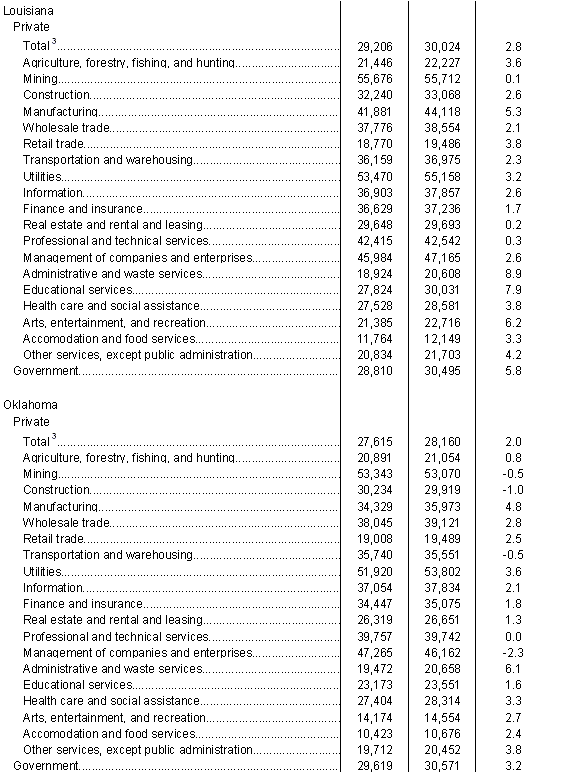
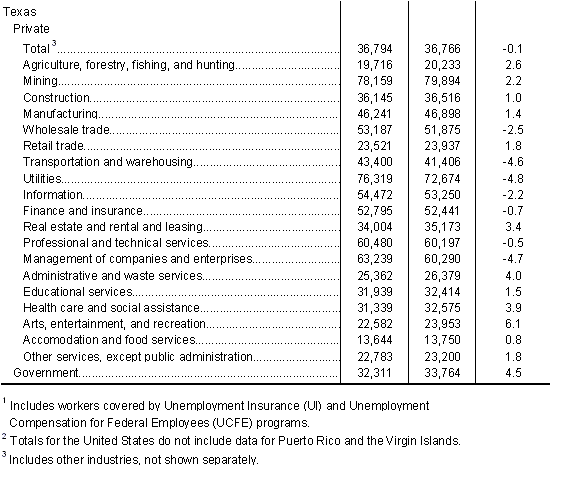
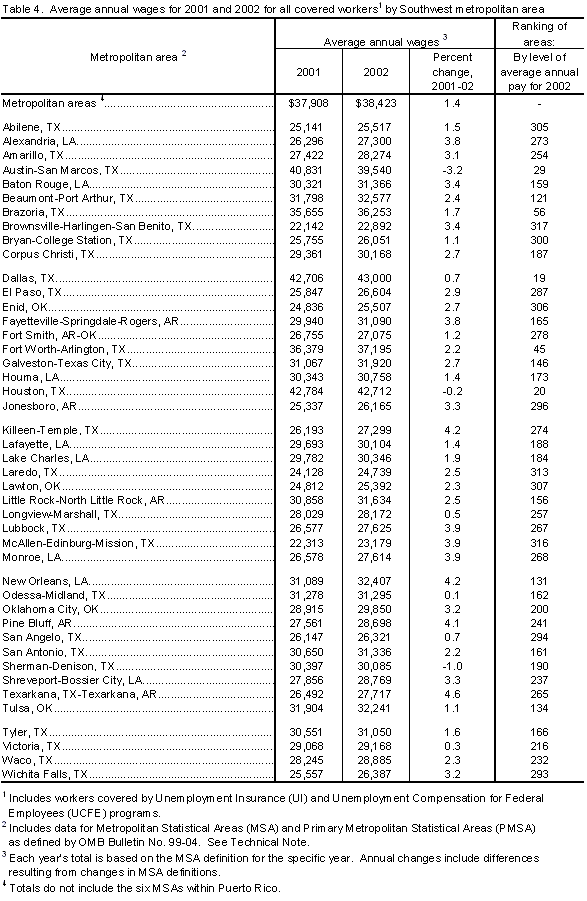
Last Modified Date: January 09, 2007

